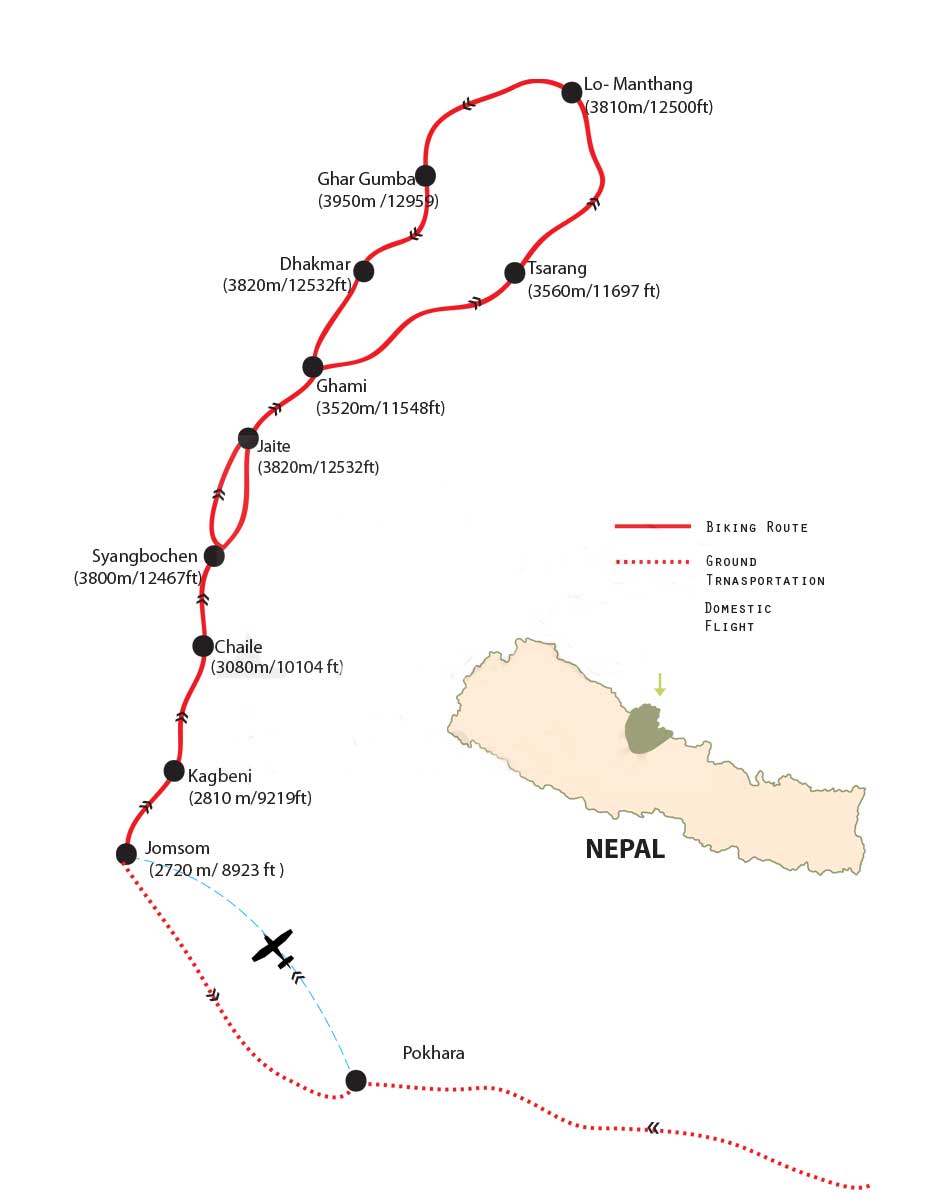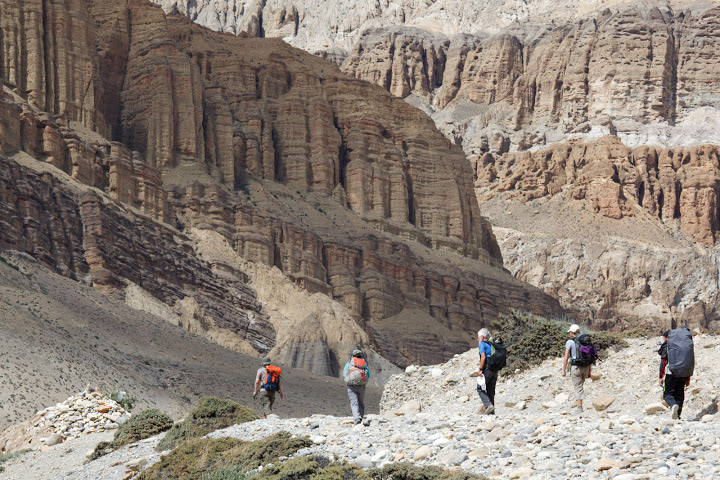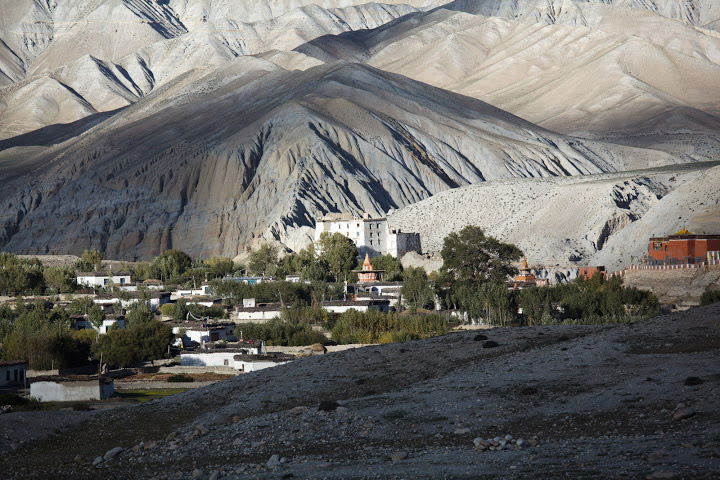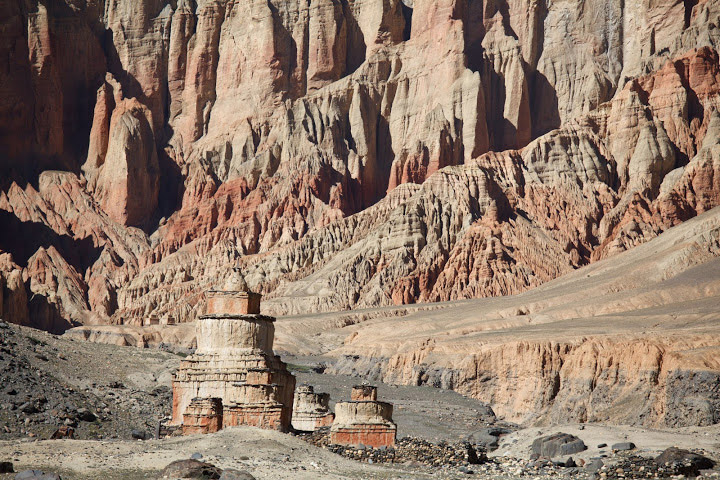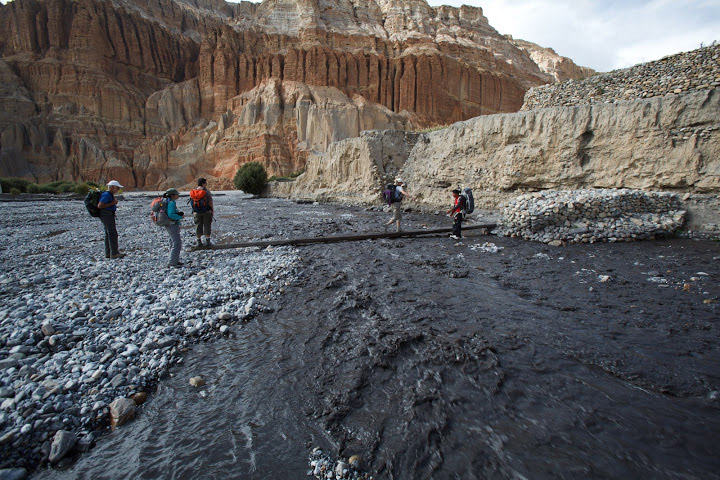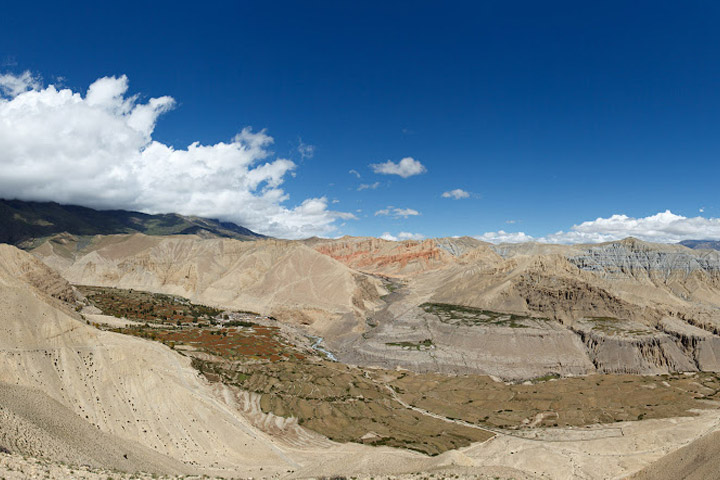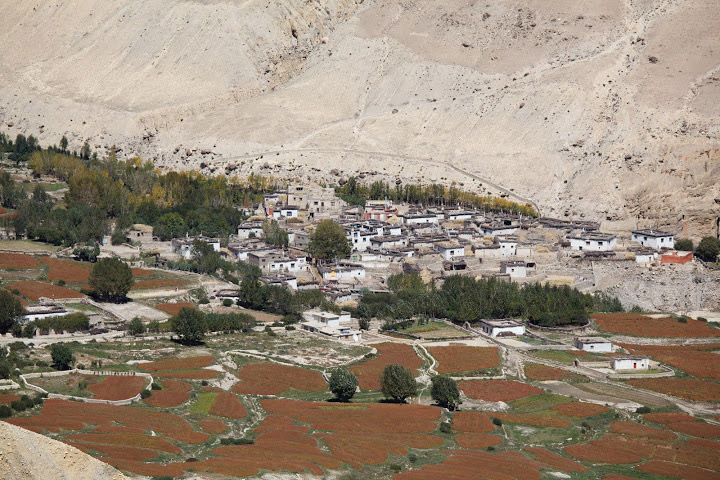Trekking into Upper Mustang is a rare and privilege opportunity, you can experience the true life of the real mountain people in Nepal. In many ways, trekking into the Upper Mustang Area is similar to trekking in to Tibet, which geographically it is a part of.
Mustang, a land where the soul of man is still considered to be as real as the feet he walks on, while the land itself is almost treeless, barren landscape with a countryside similar to Tibetan plateau, but where beauty and happiness flourishes, in spite of hardship. This was part of the Tibetan Kingdom of Gungthang until 1830’s. The fabled medieval wall city of Lo Monthang, unofficial capital of Mustang still remains a kingdom within a kingdom its full of culture and religious heritage. The early history to Lo Monthang is embellished in myth and legend rather than the recorded fact. Mustang has maintained its status as a separate principality until 1951. The king of Lo Monthang still retains his title and he has been given the honorary rank of Colonel in the Nepalese Army.
Day 01- Arrival in Kathmandu Airport (1345meters).
There you will be met by our Airport Representative and transferred to hotel by private tourist vehicle. Overnight at hotel.
Day 02- Pre-trip Meeting and Sightseeing around Kathmandu valley.
In the morning after breakfast at 9 AM, we host a Pre-Trip meeting at your hotel in Kathmandu and introduced your trek Leader/Guide mean time and it will provide an opportunity for individuals to ask questions about the your trek and to introduce you to other participants. This includes a final briefing and preparations for the trip.
PLEASE ADVISE US IF YOU WILL BE ARRIVING LATE AND ARE THEREFORE UNABLE TO ATTEND THE PRE-TRIP MEETING.
In THE PRE-TRIP MEETING All passengers MUST bring:
1. Passport.
2. Four copies of Passport size photos each.
3. Travel Insurance Policy.
4. A writing pen
5. Notepad.
After the Pre-Trip meeting and breakfast your sightseeing trip will start at 9.45 AM in the morning. We provide a private vehicle and professional tour guide. We visit Bodhnath Stupa, one of the biggest Buddhist shrines in the world, where we observe Buddhist monks in prayer in the monasteries surrounding the stupa. After Bodhnath Stupa we visit Pashupatinath, the most famous Hindu temple in the country, located on the banks of the holy Bagmati River. Here we see Hindu holy men (sadhus) meditating, pilgrims bathing and occasionally funeral pyres burning on the ghats. We also visit Bhaktapur Durbar Square, which is a collection of pagoda and shikhara – style temples grouped around a fifty-five-window palace of brick and wood. The attraction of the Bhaktapur Durbar Square is The Lion gate, The Golden gate, The Palace of fifty five windows, Art Galleries, The Statue of King Bhupatindra Malla.
The rest of our time in Kathmandu is free for further exploration and some last-minute shopping in Thamel area near by your hotel. Later, we are supplied with our Trek Pack and departure information for tomorrow. Overnight at hotel.
Day 03- Drive to Pokhara (900 meters) 7 hours by tourist bus.
Trekking staff will come to your Hotel early in the morning at 6:30 am to pick you up and then the bus leaves around 7.30 am to Pokhara. Overnight at hotel.
Day 04- Morning flight to Jomsom and trek to Kagbeni (2800 meters).
Early morning we are flying Northwest from Pokhara toward the great portal between the snow covered peaks of Annapurna and Daulagiri. You will enjoy the well-raised massifs of more than 8000 meters, and the deepest gorge on this planet.
On arrival to Jomsom you will meet the rest of the trekking staff. From Kathmandu you will have a guide with you. We start to trek towards Kagbeni, the main gate to Upper Mustang. Overnight at Tented Camp.
Day 05- Trek to Chaile (3050 meter.)
The trail leads up towards the east bank of the Kaligandaki climbing over many ridges as it heads north and reaches Tangbe village. The town is a labyrinth of narrow alleys amongst white washed houses, fields of buckwheat, barley, wheat and apple orchards. The Nilgiri peak, dominates the southern skyline of Kagbeni, all the way by different shapes. Beyond Tangbe we reach Chhusang village in about 1/2 hr, then we trek and cross the river which continues north climbing up to a huge red chunk of conglomerate that has fallen from the cliff above, forming a tunnel that the Kaligandaki follows. The trek now leaves the Kali Gandaki valley and climbs steeply up a rocky gully to Chaile. From here the culture changes from the Manangi culture to the Tibetan culture of Lo. Overnight at tented camp.
Day 06- Trek to Geling (3500 meters).
The climb continues along steep, treeless, waterless terrain, along the side of the spectacular steep canyon to a pass and cairn of rock. Then the trail makes a long gradual descent to some chortens on a ridge, and with a further descent before coming along a pleasant trail to Samar village. We climb above Samar to a ridge, then descend into a large gorge, which the trail goes into another valley field, crosses a stream and climbs up to a ridge at 3800 meters. The route climbs over yet another pass, follows a ridge and then descends to Shyangmochen. From there we gently climb to a pass at 3770meters and descend to Geling Village. Overnight at tented camp.
Day 07- Trek to Charang (3620meters).
From Geling village the trail climbs gently up to an interesting pass NYI LA and descends below the blue, gray and red cliffs. After crossing a steel bridge of the Tangmar Chu (river) you will arrive to a MANI WALL perhaps the longest and most spectacular MANI wall in Nepal. Climbing over another pass at 3600meters, the route makes a long gentle descent to Charang village. The huge five-story white Dzong and red Gompa are the main attractions to visit and observe collections of statues and Thankas as well as many large paintings, of seated Buddha’s. Overnight at tented camp.
Day 08- Trek to Lo Manthang (3840 meters).
This is an opportunity to visit two other villages on your trek. The trail climbs steadily until Lo-Gekar. Lo-Gekar Gompa is older than Samye Gompa in Tibet and one of the oldest Gompa of Nepal. After visiting Lo-Gekar continue trek to Lomanthang. The trail until Lo-Manthang is fine with some minor climbing. Finally from the ridge there is a view of the walled city of LO. After a short descent, cross a stream then climb up into the plateau of Lo-Manthang. Overnight at tented camp.
Day 09- Visit Namgyal Gompa and Tingkhar.
It takes around 2 hours to Namgyal Gompa. Namgyal Gompa situates on a hilltop, which serves as an important monastery for the local community, also serving as a local court. After visiting Namgyal Gompa continue the tour to Tingkhar, which is a village of around 40 houses, the last main village to the northwest of Lomanthang. After visiting Namgyal Gompa and Tingkhar return to Lomanthang. Overnight at tented camp.
Day 10- Trek to Dhi (3410 meters)
From Lo-Manthang the trail walks straight till Dhi pass 4100meters and descends down to Dhi village. The trek from Lo Manthang to Muktinath is harder, but more rewarding and interesting than the west side of the valley. Dhi village is one of the best villages of whole Lo-mathang and it seems more prosperous and it is settled in a very suitable place. Overnight at tented camp.
Day 11- Trek to Tange (3370 meters).
From Dhi the trail goes through the river for around 2 hours and crosses a river from Damodar Kunda, one of the sacred lakes, there is no bridge on the river so we need to walk across in bare feet to cross this river. After crossing the river the trail climbs up till high above a pass of 3850meters. The trail goes through a grassless, treeless bare hill. After the pass the trail again drops directly to Tangbe village at an elevation of 3370m.Tangbe is a small village of around 30 houses but most of the houses are attached to each other. On the rooftops one can see piles of dry woods, which also reflects the prosperity in their society. Overnight at tented camp.
Day 12- Trek to Tetang/ Chusang (3022 meters).
The trail walks through a steep ridge of hills providing some fine views of the wind carved hills. Tetang village is formed between 2 hills; they should have found it a safe place to avoid the strong wind that hits the entire Kaligandaki valley. Tetang is the upper village of the Chuksang, which we visit on the first day entering to Mustang from Kagbeni. Overnight at tented camp.
Day 13- Trek to Jomsom (2713meters).
This is the last day of the trek. The trail goes through the village of Jharkot where one can visit the many attractions such as the Jharkot monastery, Tibetan herbal medical center and the old fortress of Jharkot which once served as palace. Continuing the trek towards Jomsom one will enjoy the views of the Kaligandaki valley and Kagbeni village. This is the entry point to Mustang. We get a round trip of our trek in Ekle Bhatti visiting all the surprises of the human effort in this corner of the World of such an isolation and solitude. Arrive to Jomsom to celebrate the last day of the trek, with all the trekking staff. Overnight at tented camp.
Day 14- Morning flight to Pokhara and same day Sightseeing around Pokhara.
Today 30 minute morning flight takes us from Jomson back to Pokhara. Once we arrive at Pokhara airport, we then drive to hotel. In the afternoon we will have sightseeing tour around Pokhara valley, which covers Fewa Lake, Devi’s water fall, Museum, Tibetan refugee settlement and Gupteshower cave. Overnight at hotel.
Day 15- Leisure day in Pokhara.
It’s also spare day in case of bad weather in Jomsom. Overnight at hotel.
Day 16- Drive back to Kathmandu (1345meters).
Overnight back at the hotel in Kathmandu. If you are interested in continuing onto Chitwan Jungle Safari, River Rafting Adventure, Kathmandu Shopping Tour or Scenic Everest Flight.
Day 17- Transfer to international airport for your final departure.
The trip ends, our Airport Representative will drop you to the Kathmandu International Airport for your final flight departure from Nepal.
NOTE: The above information is a guide and standard template of what we provide. The trek can be customized at your request to accommodate your specific requirements.
Note : On adventure trips of this type, weather, local politics, transport or a multitude of other factors beyond our control can result in a change of itinerary. It is, however, very unlikely that the itinerary would be substantially altered; if alterations are necessary the leader will decide what is the best alternative, taking into consideration the best interests of the whole group. Where a change does occur, we do everything we can to minimize its effect, but we cannot be responsible for the results of changes or delays.
Q.What type of shape do I need to be in, is this trip for me?
A. Trekking is suitable for average people who are moderately fit, thus no previous experience is required. Some physical fitness programs such as running, swimming, hiking is recommended before you embark on your journey. Persons suffering from a pre-existing medical condition or disease must seek medical advice before considering the trek. Whilst on the trek, it is common to experience some discomfort before being fully acclimatized.
To prepare for a strenuous trek you should begin training at least two to three months before your departure. As a guideline, an hour of aerobic exercise three to four times per week would be considered a minimum requirement. The best preparation is bushwalking involving relatively steep ascents and descents. If you can manage a couple of valley floor to ridgeline ascents per comfortable and able to enjoy the trek to the fullest. They are physically strong, sharp-witted and have an incredibly positive attitude towards a life that we would consider extremely tough. There is something about a trek in the Himalaya that draws you back time and time again. For keen walkers it is a paradise and even avowed non-walkers find that one foot just seems to follow the other, drawn by the appeal of what lies beyond.
Q. Will somebody come to pick me up at the Airport upon my arrival?
A. Yes, our Airport Representative will be there to greet you outside of Terminal Hall, he/she will be displaying an Kiwi Adventures Treks & Expedition sign board. Upon arrival, you will be transferred to your hotel.
Q. What sort of accommodation can I expect in Kathmandu and in trekking?
A. 11 night’s Trekking Guesthouse, 4 nights three/four star hotels in Kathmandu.
We use standard rooms from three/four star hotels in Kathmandu with breakfast included. Along the trekking routes teahouses/Lodges generally provide basic clean facilities with a mattress and a quilt or blanket. We can also offer you sleeping bags if needed (which need to return after the trip) but it is a good idea to always have your own sleeping equipment. We usually provide single and double rooms as well as the occasional dormitory. The dining room is downstairs around a fire. All food will be cooked to order in the little kitchen. You should not enter the kitchen unless asked to do so.
Q. What sort of food can I expect in trekking?
A. In trekking most teahouses (lodges) cook a delicious range of mostly vegetarian fare. Pasta, tuna bakes, noodles, potatoes, eggs, dhal bhat, bread, soups, fresh vegetables (variety depends on the season) and even some desserts like apple pies, pancakes, and some interesting attempts at custard. You will find a lot of garlic on the menu because it assists with acclimatization – eat some every day. In many larger villages you may find some meat on the menu. You can always get hot chocolate, tea, and hot lemon drinks, as well as soft drinks, and treats like chocolate and crisps.
Each day dinner and breakfast are used to take in the same lodge you spend the night. Lunch will be taken on the way to destination.
Q. What sort of transportation you use?
A. Kiwi Adventures Treks & Expedition is all about providing you with local insights as well as adventure, with that in mind, where we think you will get more out of your holiday by using different means of transport that is what we do. Using a variety of private transport is an integral part of our Himalaya tours and enhances the experience!
We use private tourist vehicles for sightseeing, city tours and pickups. Depending on the group size we use cars, minibus, van or land cruiser. These small light vehicles are more manoeuvrable and flexible enabling us to take you through the Narrow roads of Nepal. All the vehicles are usually air-conditioned unless we are travelling in cooler areas.
Q. What is the best season for this trekking?
A. Our trekking season extends from mid- September to May. From early September the monsoonal rains decrease. By end of September through to December the weather is usually stable with mild to warm days, cold nights. February, March, April, May, October, November, December are the best time to do trek.
Q. What is the weather & temperature like in trekking?
A. Weather in the mountains is notoriously difficult to predict. At night it is generally cooler the days are generally warm. Winter (January and February) will be bit colder but the days can be quite beautiful and warm if the sun is out. There will be bit of snow during the month of January, February and December. It is also important to make sure that you can stay warm and dry in just about any conditions. Expect the unexpected! The temperature could be as high as 20 deg C to -15 deg C low.
Q. Can I charge my digital camera or other batteries on my trip?
A. These facilities will be available in most of the places in your hotel reception by paying some service charges. Remember to bring your adapters!
Q. Is there any communication while we are on trekking?
A. There are telephones in some villages along the trekking routes from which you can make international calls.
Q. Can I use credit cards in the places visit in trekking?
A. In most cities yes, to some extent, however once you leave those cities behind, all you need is cash.
Q. How much additional money do I need per day?
A. In Kathmandu, you can allocate US$ 10 – 25 for a lunch / dinner. It’s all depends on your spending habits. US$7 to 10 US$ a day will be enough to buy bottles of water, chocolates and few drinks in trekking.
Q. Do I need to tip my guide and porters? How much would that be?
A. This is a difficult thing to gauge. We have seen everything from 20USD to 1000 USD per person for guides and porters. Tipping is not required, but a small way to show your guides and local porters thanks for their help. The level of the tip should reflect the level of personal involvement with your guide.
Q. Is the water OK to drink? Do I need to bring purifying tablets/filter?
A. In most places bottled water is readily available. If you wish to drink normal water, you need to use purifying aid, which you will need to bring with you.
Q. Are the Kiwi Adventures Treks & Expedition staff insured?
A. Our company insures all our trekking staff, including guide, cook, sherpa and porters.
Q. What essential documents do I need to bring with me on tour?
A. *Valid Passport – must be valid for up to 6 months after you return from your tour, keep a separate photocopy.
*Travel insurance, keep a separate photocopy
*Cash and Traveller’s Cheques, keep numbers and proof of purchase separate
*Flight tickets
*Emergency contact numbers for T/C’s, banks, insurance, family contacts.
Q. Can I add extra days to my trekking trip?
A. A hoilday should never be about making it to the final point quickly. Along your trek we can add days at your request with additional costs to cover guides, porters, accommodation and food.
Q. Do you use yaks/porters on the trek or do we carry all of our own gear?
A. Whilst on the trek, our porter will take care of your luggage. All you need to carry is your small day bag for your personal belongings like camera, water bottle, sun cream etc only.
Q. What opportunities will I have for shower along the trek?
A. In major places, we arrange guesthouse with hot shower. And in rest of the places, hotel water in bucket will be provided for shower; it would cost you extra about USD 3-4 per shower.
Q. Do you know about how many total miles the trek is?
A. Total distance of the entire trek is about 75 miles.
Cost Includes
• Airport / Hotel / Airport pick up & drop by private car / van / bus.
• Standard twin sharing accommodation in three/four star hotel in Kathmandu breakfast included.
• Standard twin sharing accommodation in two/three star hotel in Pokhara breakfast included.
• Guided city tour in Kathmandu and Pokhara by private car / van / bus.
• All your standard Meals during the trek.
• Twin sharing Lodges, Guesthouses accommodation during the trek.
• Airfare from Kathmandu – Pokhara, Pokhara – Jomsom including airport departure tax in Kathmandu and Pokhara airport.
• Local K2 Summit licensed English speaking Guide.
• The required number of local staff and Porters to carry your luggage during the trek.
• Food, accommodation, salary, insurance, equipment and medicine for all staff.
• Annapurna conservation Park permits.
• Sightseeing Fees
• Surface transfer from and to Kathmandu.
• All our government taxes.
• Official expense.
Cost Excludes
• Lunch and dinner whilst in Kathmandu and Pokhara .
• Your travel insurance (compulsory, please contact us if you wish to sign up for the Global Rescue membership plan).
• International airfare and airport departure tax.
• Nepal entry visa, you can obtain a visa easily upon your arrival at Tribhuwan International Airport in Kathmandu. (Tourist Visa with Multiple Entry for 30 days can be obtained by paying US $ 40 or equivalent foreign currency. Similarly, Tourist Visa with Multiple Entry for 90 days can be obtained by paying US $ 100. You will also require 2 passport size photos.)
• Alcoholic, hot and cold drinks.
• Personal trekking Equipment.
• Tips for trekking staff. (Tipping is expected).
• Any others expenses which are not mentioned on Price Includes section.
